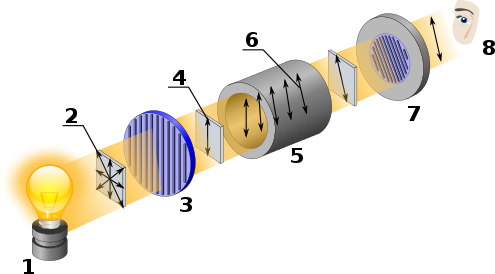Polarimetry
Polarimetry measures the polarisation of light. The light emitted by a star is unpolarised. This means the waves of light oscillate in random directions. When light from a star hits gas or dust in space, it is re-emitted and scattered. This can result in polarisation. Strong magnetic fields can also produce polarised radiation.

1. Light source 2. Unpolarized light 3. Linear polarizer
4. Linearly polarized light 5. Sample tube containing
molecules under study 6. Optical rotation due to molecules
7. Rotatable linear analyzer 8. Detector
Credit: By Kaidor CC BY-SA 3.0
We can fit telescopes with filters that separate the light of one polarisation from another. These tools are called polarisers and only allow light through that is oscillating in a particular direction. A similar principle is often used in sunglasses. Polarised lenses reduce the amount of light that passes to the wearer's eyes.
Polarimetry has lots of applications. It is used to hunt for exoplanets and galactic nuclei. It can help us learn more about planetary atmospheres and surfaces. It can also be used to make maps of magnetic fields around black holes. However, because polarisers block out some light, this method is best for studying very bright objects.

